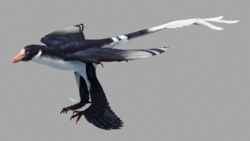Zhongjianosaurus
| Zhongjianosaurus | |
|---|---|

| |
| An artist's reconstruction of Zhongjianosaurus yangi | |
| Scientific classification | |
| Domain: | Eukaryota |
| Kingdom: | Animalia |
| Phylum: | Chordata |
| Clade: | Dinosauria |
| Clade: | Saurischia |
| Clade: | Theropoda |
| Family: | †Dromaeosauridae |
| Clade: | †Microraptoria |
| Genus: | †Zhongjianosaurus Xu & Qin, 2017 |
| Type species | |
| †Zhongjianosaurus yangi Xu & Qin, 2017
| |
Zhongjianosaurus is a genus of
Description

Zhongjianosaurus is distinguishable from other microraptorines in the following
The articulated tail has elongate rod-like extensions of the prezygaphophyses and chevrons characteristic of most dromaeosaurids, and these reach almost to the most anterior caudals. The sternum is large, with a maximum anteroposterior length 56% of the femoral length and is long axially in proportion. Bone fusion in the scapula, vertebrae, coracoid, and tarsals suggest that the specimen is a mature adult weighing 0.31 kg (0.68 lb), making it one of the smallest known non-avian theropods thus far discovered.[1]
Discovery and naming
Zhongjianosaurus was first reported in 2009 when a new species based on a specimen consisting of a partial postcranial articulated skeleton was recovered from the lake deposits in Sihedang, Lingyuan County, in western Liaoning, China. It was first described by Xu Xing and Qin Zi-Chuan. The genus and specific name honor Yang Zhongjian, China's founder of vertebrate paleontology. The holotype specimen, labelled as IVPP V 22775, is currently housed in the Institute of Vertebrate Paleontology and Paleoanthropology, in Beijing.[1]
The specimen's remains preserve the four most posterior cervical vertebrae (likely 7–10 in regards to placement). Seven dorsal vertebrae are known, while eight dorsal ribs are known from the left side of the specimen in comparison to the five preserved for the right side. Five left uncinate processes are preserved as well. The caudal series of vertebrae are represented by 26 articulated caudal vertebrae, probably missing only the first caudal vertebra, likely making a full count of 27 caudal vertebrae in the tail. The sternum is represented by what is probably the left sternal plate. Five left sternal ribs are preserved, more than are seen in the related genera Microraptor and Sinornithosaurus. The furcula is preserved as well, as are the scapulae and coracoids, which are fused. The forelimbs of Zhongjianosaurus are represented by both humeri, the left ulna, the left radius, and a partial left manus. The specimen's hindlimbs meanwhile, are represented by both femora, both tibiotarsi, and portions of both feet.[1]
Classification
Studies by Xu and Qin place Zhongjianosaurus in the Dromaeosauridae, and specifically the Microraptoria, based on its synapomorphies.[1] Some studies offer an alternate position as an avialan.[2][3]
Paleobiology
The discovery of Zhongjianosaurus in the Yixian Formation, in addition to eight other dromaeosaurids suggests that there was a sufficient amount of
